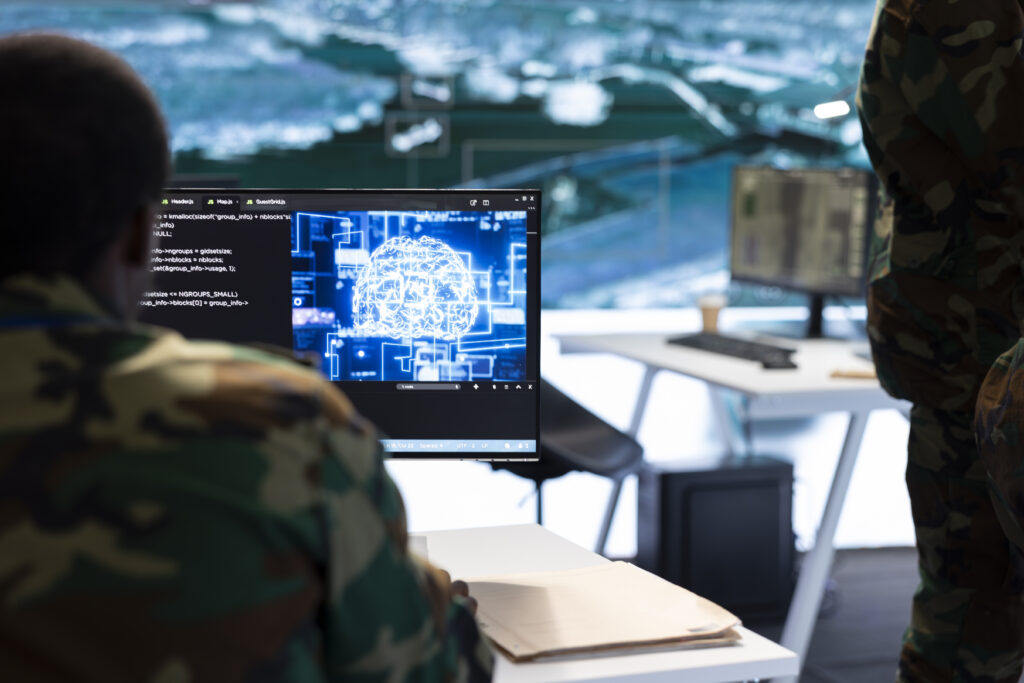Interviews / Europe, Strategy, Security
23 June 2025
What Role Is AI Likely to Play in the Future of Defence?

At the heart of technological innovation, artificial intelligence (AI) is becoming an integral part of the defensive and operational apparatus of the states investing in it. As a tool for detection, interpretation, and suggestion, its use brings such efficiency gains that its mastery becomes a genuine asset on the international stage. It is beginning to reshape market dynamics as actor diversification accelerates. To what extent is AI establishing itself as the future of military practice? In light of this reality, who are the key players in the development of AI? What stance are France and Europe taking on the matter? We explore the issue with Alain Filipowicz, Associate Research Fellow at IRIS.
AI is a prominent feature at this year’s 55th Paris Air Show. It seems to be increasingly integrated into defence equipment and in more sophisticated ways, leaving less responsibility to humans. Is AI the future of warfare, and will mastering it bring absolute superiority?
When it comes to the use of AI in defence systems, we should not speak of a loss of responsibility. That would be a serious mistake, potentially leading to disastrous consequences, such as those portrayed in Dr Strangelove, where the doomsday machine, copied from the Americans and implemented by the Soviets, automatically launches a nuclear retaliation in response to an error. There are three types of AI use in defence systems. First, AI for sensors, which processes various signals (images, videos, sounds, vibrations, etc.) to provide not raw data for human interpretation but processed information (e.g., on such a date and time, I saw this or that). Second, generative AI, which, having absorbed vast corpora of textual data, helps save time when drafting various texts (reports, analyses, etc.). Finally, AI for strategic decision support, which goes beyond the first two by integrating data of various types and offering, for instance, analyses of enemy behaviour and forecasts of their actions. In light of these uses, AI is clearly part of the future of military operations, as it saves time, reduces cognitive load, detects weak signals, and offers strategic insights. However, humans must remain in control at all times—redefining the art of war by blindly trusting AI would be suicidal. As for the notion of absolute superiority brought by AI, this issue is not specific to AI but rather falls within the traditional question of symmetry or asymmetry in conflicts and the forces involved.
Where do France and the European Union (EU) stand in terms of AI mastery? What are their strengths and weaknesses? Who are the main competitors?
AI is a national priority for France. The state has launched several academic laboratory clusters in collaboration with numerous companies, including some that play significant roles in the defence economy. These include the 3IA centres launched in 2018 in Paris, Nice, Grenoble, and Toulouse. At the European level, the situation varies between Member States. The EU should launch a major Important Project of Common European Interest (IPCEI) specifically on AI, as it has recently done for electronics, telecoms, and batteries. That said, the technological powerhouses of the United States (with the GAFAMs) and China (with the BHATX) are formidable, hegemonic, and imperialist. Faced with the imposition of AI models developed in these countries, France and Europe still hold some valuable cards: legislating on the use of AI to prevent reckless deployment, as is tempting for many governments; developing trustworthy and high-performance AI systems that, unlike some non-European “sorcerer’s apprentice” approaches, ensure operational reliability and result traceability. Failing to do so may one day lead to global rejection of these technologies, akin to the “Butlerian Jihad” in Frank Herbert’s Dune. It would also be wise to direct AI applications towards areas that genuinely need them: does the autonomous vehicle truly make sense when fewer citizens can afford new vehicles, which are already prohibitively expensive, and when our roads, cities, laws, and behaviours are ill-suited to such technology? Only through collaboration between our businesses, laboratories, and state services can we Europeans carve out a place in a world the GAFAMs and BHATXs clearly seek to dominate and control.
The idea of dual-use (civilian and military) technologies often comes up in the French Defence Minister’s discourse. Is AI a response to this objective, and can it help bring civilian industry players into the defence sector?
The pursuit of dual-use technologies (civilian and military) has existed in the armed forces for several decades and receives both close attention and active support to foster its development. One reason is that when equipping a national army—despite exporting equipment abroad—designing and manufacturing purely military systems is not always profitable for companies, whether they are start-ups, SMEs, mid-size firms, or large groups. The same applies to the technologies and components within these systems, which may be far less costly if sourced from the civilian sector and produced or used on a large scale. Dual-use innovation must therefore be integrated at all levels of a system. AI is naturally part of this logic. Today, it is a critical software component. A service or system incorporating AI can, in some cases, significantly boost performance, efficiency, and time-saving. This makes it essential for the French—and more broadly, the European—Defence Industrial and Technological Base (BITD and BITD-E) to adopt it, especially within a dual-use framework. As mentioned earlier, rearming Europe and enhancing the performance of our economies calls for deep collaboration. The EU and its Member States have understood this by requiring grant beneficiaries to share their project outcomes and adopt more open approaches to intellectual property within European companies. Nevertheless, this must not be done naively, given the aggressive industrial espionage practices of non-European competitors and their disregard for intellectual property rights. Clearly, many companies will need to be considered as future contributors to the BITD.

